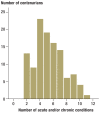Health and Disease at Age 100
- PMID: 27118718
- PMCID: PMC5400033
- DOI: 10.3238/arztebl.2016.0203
Health and Disease at Age 100
Erratum in
-
Erratum.Dtsch Arztebl Int. 2016 Jun 6;113(22-23):395. doi: 10.3238/arztebl.2016.0203. Dtsch Arztebl Int. 2016. PMID: 27374376 Free PMC article. No abstract available.
Abstract
Background: Centenarian studies from around the world have shown that reaching age 100 typically involves substantial health issues. The present study adds to the existing knowledge from other countries by describing health conditions in German centenarians.
Methods: A total of 112 centenarians or their primary contacts provided information on acute and chronic health conditions and pain in the context of the Second Heidelberg Centenarian Study (mean age = 100.45 years, standard deviation [SD] = 0.47, 89% females).
Results: Participants showed high comorbidity, with an average of five illnesses (mean = 5.3; SD = 2.20). Health conditions with highest prevalence were sensory (vision, hearing; 94%), mobility (72%) and musculoskeletal conditions (60%). Cardiovascular conditions (57%) and urinary system ailments (55%) were also common. Pain was experienced often by 30% of the participants. Of those reporting any pain, 36% indicated pain exceeding bearable levels.
Conclusion: German centenarians experienced a substantial number of ill nesses, dominated by sensory and mobility conditions. Cardiovascular diseases were the only potentially lethal illnesses with high prevalence. Evidence of unaddressed pain seems alarming, requiring future research. Emerging health profiles indicate that even in very advanced age, quality of life may be improved by enhanced diagnostics and optimal disease management. Mobility limitations may be addressed with preventive efforts.
Figures
References
-
- Vaupel JW, Carey JR, Christensen K, et al. Biodemographic trajectories of longevity. Science. 1998;280:855–860. - PubMed
-
- Rochon PA, Gruneir A, Wu W, et al. Demographic characteristics and healthcare use of centenarians: A population-based cohort study. J Am Geriatr Soc. 2014;62:86–93. - PubMed
-
- Richmond RL, Law J, Kay-Lambkin F. Physical, mental, and cognitive function in a convenience sample of centenarians in Australia. J Am Geriatr Soc. 2011;59:1080–1086. - PubMed
-
- Motta M, Ferlito L, Magnolfi S, et al. Cognitive and functional status in the extreme longevity. Arch Gerontol Geriatr. 2008;46:245–252. - PubMed
MeSH terms
LinkOut - more resources
Full Text Sources
Other Literature Sources
Medical


